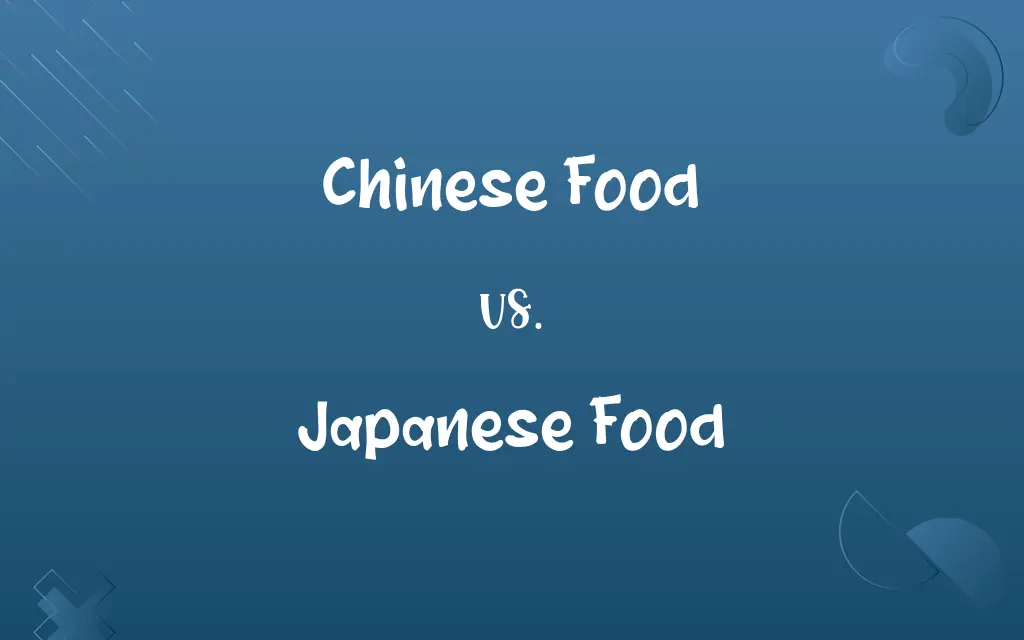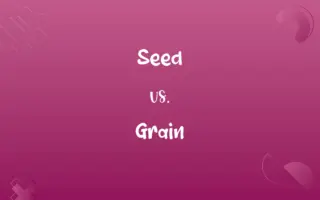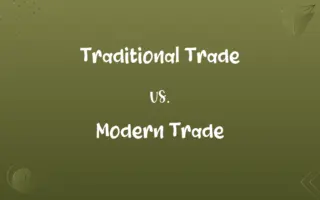Chinese Food vs. Japanese Food: Know the Difference

By Hifza Nasir & Shumaila Saeed || Published on April 23, 2024
Chinese food emphasizes bold flavors and varied cooking methods, including stir-frying and steaming, while Japanese food focuses on the natural taste of ingredients, featuring techniques like sushi making and tempura frying.

Key Differences
Chinese cuisine is known for its diverse flavors and ingredients, with each region offering its unique dishes, such as Sichuan’s spicy food and Cantonese dim sum. Japanese cuisine, on the other hand, prioritizes simplicity and the natural flavors of seasonal ingredients, exemplified by dishes like sushi and sashimi.
Shumaila Saeed
Apr 23, 2024
Cooking techniques in Chinese food often involve quick methods like stir-frying, deep-frying, and steaming, allowing for a wide variety of textures and flavors. Japanese cooking tends to employ more subtle techniques, including grilling (yakitori) and simmering (nimono), to preserve the food's inherent taste.
Shumaila Saeed
Apr 23, 2024
Chinese meals frequently feature a combination of dishes served family-style, encouraging shared dining experiences. Japanese meals often center around a set of dishes served to individuals, including a main dish, rice, soup, and pickles, highlighting a more structured dining etiquette.
Hifza Nasir
Apr 23, 2024
The use of seasonings and condiments differs significantly; Chinese cuisine uses a broad array of sauces, including soy sauce, oyster sauce, and black bean sauce, to enhance flavors. Japanese cuisine relies more on the delicate use of soy sauce, miso, and wasabi, aiming to complement rather than overshadow the natural taste of the food.
Shumaila Saeed
Apr 23, 2024
Presentation is another distinguishing factor; Japanese dishes are meticulously plated to appeal to the senses, emphasizing seasonal themes and artistic arrangement. Chinese food, while also presented with care, focuses more on the abundance and variety of the food.
Hifza Nasir
Apr 23, 2024
ADVERTISEMENT
Comparison Chart
Flavor Profile
Bold and diverse, with heavy use of spices.
Subtle and natural, focusing on the purity of ingredients.
Shumaila Saeed
Apr 23, 2024
Cooking Techniques
Stir-frying, deep-frying, steaming.
Sushi making, tempura frying, grilling, simmering.
Hifza Nasir
Apr 23, 2024
Dining Style
Family-style with shared dishes.
Individual servings with a set menu format.
Hifza Nasir
Apr 23, 2024
Seasonings
Wide variety, including soy sauce, oyster sauce.
Delicate use of soy sauce, miso, wasabi.
Hifza Nasir
Apr 23, 2024
Presentation
Focus on variety and abundance.
Emphasis on aesthetic arrangement and seasonality.
Shumaila Saeed
Apr 23, 2024
ADVERTISEMENT
Chinese Food and Japanese Food Definitions
Chinese Food
Emphasizes the balance of flavors.
Sweet and sour pork perfectly balances tanginess and sweetness.
Hifza Nasir
Feb 27, 2024
Japanese Food
Incorporates a minimalist approach to seasoning.
A dash of soy sauce is often all that's needed for flavoring.
Hifza Nasir
Feb 27, 2024
Chinese Food
Often served family-style.
A typical Chinese meal includes several dishes shared by everyone at the table.
Shumaila Saeed
Feb 27, 2024
Japanese Food
Presentation is key, with an emphasis on seasonal themes.
Sakura mochi is a seasonal delicacy that celebrates cherry blossom season.
Hifza Nasir
Feb 27, 2024
Chinese Food
Known for its regional diversity and bold flavors.
The Sichuan dish, mapo tofu, is celebrated for its spicy and bold taste.
Shumaila Saeed
Feb 27, 2024
ADVERTISEMENT
Japanese Food
Famous for sushi, a symbol of Japanese culinary art.
Sushi rolls demonstrate the delicate balance of rice, fish, and seaweed.
Shumaila Saeed
Feb 27, 2024
Chinese Food
Features a wide range of ingredients.
Chinese hot pots include everything from leafy vegetables to thinly sliced meats.
Hifza Nasir
Feb 27, 2024
Japanese Food
Served in a structured set menu format.
A traditional Japanese meal might include miso soup, rice, and a main dish.
Dua Fatima
Feb 27, 2024
Chinese Food
Utilizes a variety of cooking methods.
Peking duck showcases the skill of roasting to achieve crispy skin.
Shumaila Saeed
Feb 27, 2024
Japanese Food
Prioritizes the natural taste of high-quality ingredients.
Sashimi highlights the fresh, natural flavor of seafood.
Hifza Nasir
Feb 27, 2024
Repeatedly Asked Queries
How do serving styles differ between Chinese and Japanese food?
Chinese food is often served family-style with shared dishes, while Japanese food typically comes in individual servings as part of a set menu.
Hifza Nasir
Apr 23, 2024
Is sushi Chinese or Japanese?
Sushi is a Japanese dish, characterized by its use of vinegared rice combined with various ingredients like seafood and vegetables.
Shumaila Saeed
Apr 23, 2024
What is a common cooking technique in Chinese cuisine?
Stir-frying is a common cooking technique in Chinese cuisine, allowing for quick cooking at high heat.
Hifza Nasir
Apr 23, 2024
How do Chinese and Japanese cuisines differ in their use of spices?
Chinese cuisine uses a wide variety of spices to create bold flavors, while Japanese cuisine uses fewer spices, focusing on the natural flavors of the ingredients.
Hifza Nasir
Apr 23, 2024
What is the main difference between Chinese and Japanese food?
The main difference lies in flavor profiles and cooking techniques, with Chinese food being bold and diverse, and Japanese food focusing on natural tastes and minimalism.
Shumaila Saeed
Apr 23, 2024
What Japanese dish emphasizes the use of grilling?
Yakitori, skewered chicken grilled over charcoal, is a Japanese dish that emphasizes the use of grilling.
Shumaila Saeed
Apr 23, 2024
What role does presentation play in Japanese cuisine?
Presentation plays a significant role in Japanese cuisine, with dishes carefully arranged to appeal visually and reflect seasonal themes.
Shumaila Saeed
Apr 23, 2024
What is a distinctive feature of Japanese soups?
A distinctive feature of Japanese soups, like miso soup, is their use of dashi as a base, which provides a rich, umami flavor.
Hifza Nasir
Apr 23, 2024
Can you name a Chinese dish that showcases deep-frying?
Sweet and sour pork is a popular Chinese dish that showcases deep-frying to achieve a crispy texture.
Hifza Nasir
Apr 23, 2024
Are there vegetarian options in Chinese and Japanese cuisines?
Yes, both cuisines offer vegetarian options, though they may be more abundant and varied in Chinese cuisine due to its regional diversity.
Dua Fatima
Apr 23, 2024
What Chinese sauce is known for its bold flavor?
Oyster sauce is known for its bold flavor, commonly used in Chinese cooking to enhance meat and vegetable dishes.
Hifza Nasir
Apr 23, 2024
How does the use of rice differ between Chinese and Japanese cuisines?
Rice is a staple in both cuisines, but in Japanese cuisine, it's often served as a separate dish, while in Chinese cuisine, it can be mixed with other ingredients, as in fried rice.
Hifza Nasir
Apr 23, 2024
What is a key feature of Japanese seasonality in cuisine?
Japanese cuisine emphasizes seasonal ingredients, with dishes often reflecting the current season, such as spring bamboo shoots or autumn mushrooms.
Hifza Nasir
Apr 23, 2024
How do Chinese and Japanese cuisines approach the concept of umami?
Both cuisines value umami; Chinese cuisine achieves it through a variety of sauces and seasonings, while Japanese cuisine finds it in simpler, more natural ingredients like seaweed and soy sauce.
Dua Fatima
Apr 23, 2024
What is a popular Japanese dish that uses tempura frying?
Tempura, consisting of seafood and vegetables lightly battered and fried, is a popular Japanese dish that showcases tempura frying.
Shumaila Saeed
Apr 23, 2024
Share this page
Link for your blog / website
HTML
Link to share via messenger
About Author
Written by
Hifza NasirCo-written by
Shumaila SaeedShumaila Saeed, an expert content creator with 6 years of experience, specializes in distilling complex topics into easily digestible comparisons, shining a light on the nuances that both inform and educate readers with clarity and accuracy.







































































